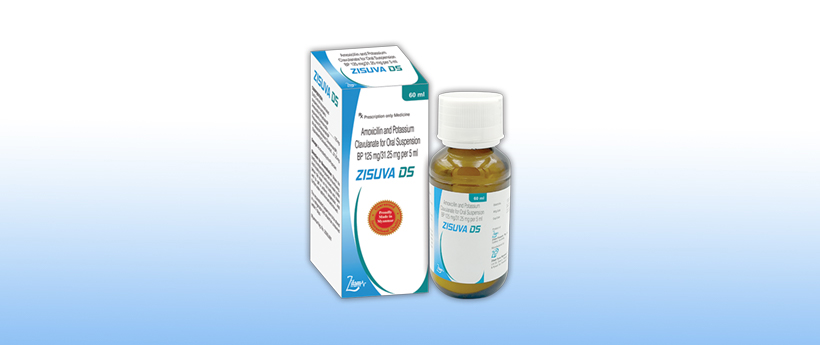ZISUVA DS
- ENG
- မြန်မာ

Amoxicillin and Potassium Clavulanate for Oral Suspension BP 125 mg/31.25 mg per 5 ml
Composition:
Each 5 ml of reconstituted suspension contains
Amoxicillin Trihydrate BP equivalent to Amoxicillin ………………125 mg
Potassium Clavulanate BP
(as diluted Potassium Clavulanate BP)
equivalent to Clavulanic Acid………………………………………………………31.25 mg
INDICATIONS
Treatment of otitis media, sinusitis, and infections caused by susceptible organisms involving the lower respiratory tract, skin and skin structure, and urinary tract; spectrum same as amoxicillin with additional coverage of beta-lactamase producing B. catarrhalis, H. influenzae, N. gonorrhoeae, and S. aureus (not MRSA). The expanded coverage of this combination makes it a useful alternative when amoxicillin resistance is present and patients cannot tolerate alternative treatments.
Dosage
ZISUVA (Oral Suspension)
Children:
The usual recommended daily dosage is 25mg/kg/day in divided dosas every right hours. In more serious infections, the dosage may increased up to 50 mg/kg/day in divided dosage every right hours.
Adults:
Adults who have difficulty swallowing may be given the Amoxucillin and Clavulanate Potassium for Oral Suspension.
WARNINGS:
Concerns related to adverse effects:
- Anaphylactoid/hypersensitivity reactions:
Serious and occasionally severe or fatal hypersensitivity (anaphylactoid) reactions have been reported in patients on penicillin therapy, especially with a history of beta-lactam hypersensitivity, history of sensitivity to multiple allergens, or previous IgE-mediated reactions (eg, anaphylaxis, angioedema, urticaria). Use with caution in asthmatic patients. Low incidence of cross-allergy with cephalosporins exists. - Diarrhea: Incidence of diarrhea is higher than with amoxicillin alone.
- Hepatic effects: Although rare, hepatic dysfunction is more common in elderly and/or males, and occurs more frequently with prolonged treatment, and may occur after therapy is complete.
- Superinfection: Prolonged use may result in fungal or bacterial superinfection, including
- difficile – associated diarrhea (CDAD) and pseudomembranous colitis; CDAD has been observed > 2 months postantibiotic treatment.
Disease-related concerns:
- Hepatic impairment: Use with caution in patients with hepatic impairment.
- Infectious mononucleosis: A high percentage of patients with infectious mononucleosis have developed rash during therapy; ampicillin-class antibiotics not recommended in these patients.
- Renal impairment: Use with caution in patients with renal impairment; dosage adjustment recommended
Dosage form specific issues:
- Due to differing content of clavulanic acid, not all formulations are interchangeable.
Concerns related to Pregnancy and lactation:
Pregnancy Animal studies do not indicate direct or indirect harmful effects with respect to pregnancy, embryonal / foetal development, parturition or postnatal development
- Limited data on the use of amixicillin
and clavulanic acid during pregnancy in humans do not indicate an increased risk of congenital malformations, In a single study in women with preterm, premature rupture of the foetal membrane it was reported that prophylactic treatment with amoxicillin and clavulanic acid may be associated with an increased risk of necrotising enterocolitis in neonates. Use should be avoided during pregnancy, unless considered essential by the physician.
Lactation Both substances are excreted into breast milk (nothing is known of the effects of clavulanic acid on the breast-fed infant).
Consequently, diarrhoea and fungus infection of the mucous membranes are possible in the breast-fed infant, so that breast-feeding might have to be discontinued. Amoxicillin and clavulanic acid should only be used during breast-feeding after benefits – risk assessment by the physician in charge.
DRUG INTERACTIONS
Allopurinol: May enhance the potential for allergic or hypersensitivity reactions to Amoxicillin. Risk C: Monitor therapy
Fusidic Acid: May diminish the therapeutic effect of Penicillins. Risk D: Consider therapy modification
Methotrexate: Penicillins may decrease the excretion of Methotrexate. Risk C: Monitor therapy
Mycophenolate: Penicillins may decrease serum concentrations of the active metabolite(s) of Mycophenolate. This effect appears to be the result of impaired enterohepatic recirculation. Risk C:
Monitor therapy
Tetracycline Derivatives: May diminish the therapeutic effect of Penicillins. Risk D:
Consider therapy modification
Typhoid Vaccine: Antibiotics may diminish the therapeutic effect of Typhoid Vaccine.
Only the live attenuated Ty21a strain Is affected. Risk D: Consider therapy modification
Uricosuric Agents: May decrease the excretion of Penicillins. Risk C: Monitor therapy
SIDE-EFFECTS AND SPECIAL PRECAUTIONS
Amoxicillin and Potassium Clavulanate is generally well tolerated. The majority of side effects observed in clinical trials were of a mild and transient nature and less than 3% of patients discontinued therapy because of drug-related side effects. The most frequently reported adverse effects were diarrhea/loose stools (9%), nausea (3%), skin rashes and urticaria (3%), vomiting (1%) and vaginitis (1%). The overall incidence of side effects, and in particular diarrhea, increased with the higher recommended dose. Other less frequently reported reactions include: Abdominal discomfort, flatulence, and headache.
OVERDOSAGE:
Following overdosage, patients have experienced primarily gastrointestinal symptoms including stomach and abdominal pain, vomiting, and diarrhea. Rash, hyperactivity, or drowsiness have also been observed in a small number of patients.
In the case of overdosage, discontinue amoxicillin and potassium clavulanate, treat symptomatically, and institute supportive measures as required. If the overdosage is very recent and there is no contraindication, an attempt at emesis or other means of removal of drug from the stomach may be performed. A prospective study of 51 pediatric patients at a poison center suggested that overdosages of less than 250 mg/kg of amoxicillin are not associated with significant clinical symptoms and do not require gastric emptying.
STORAGE
Store below 30°C. Protect from light and moisture.
KEEP MEDICINE OUT OF REACH OF CHILDREN.
PRESENTATION:
Zisuva DS- 60ml or 100ml glass bottle in a carton along with measuring cup and pack insert.
Manufactured by:
Zifam Pyrex Myanmar Co., Ltd.
Lot C6, Zone-A, Thilawa SEZ, Thanlyin and Kyaut Tan Township, Yangon, Myanmar.
Product of
Zifam Pinnacle Pty.Ltd
The Healthcare Group
updated on 6.2.2024





